This Week At Angama #49
11 January 2019 | This Week at Angama | Adam Bannister
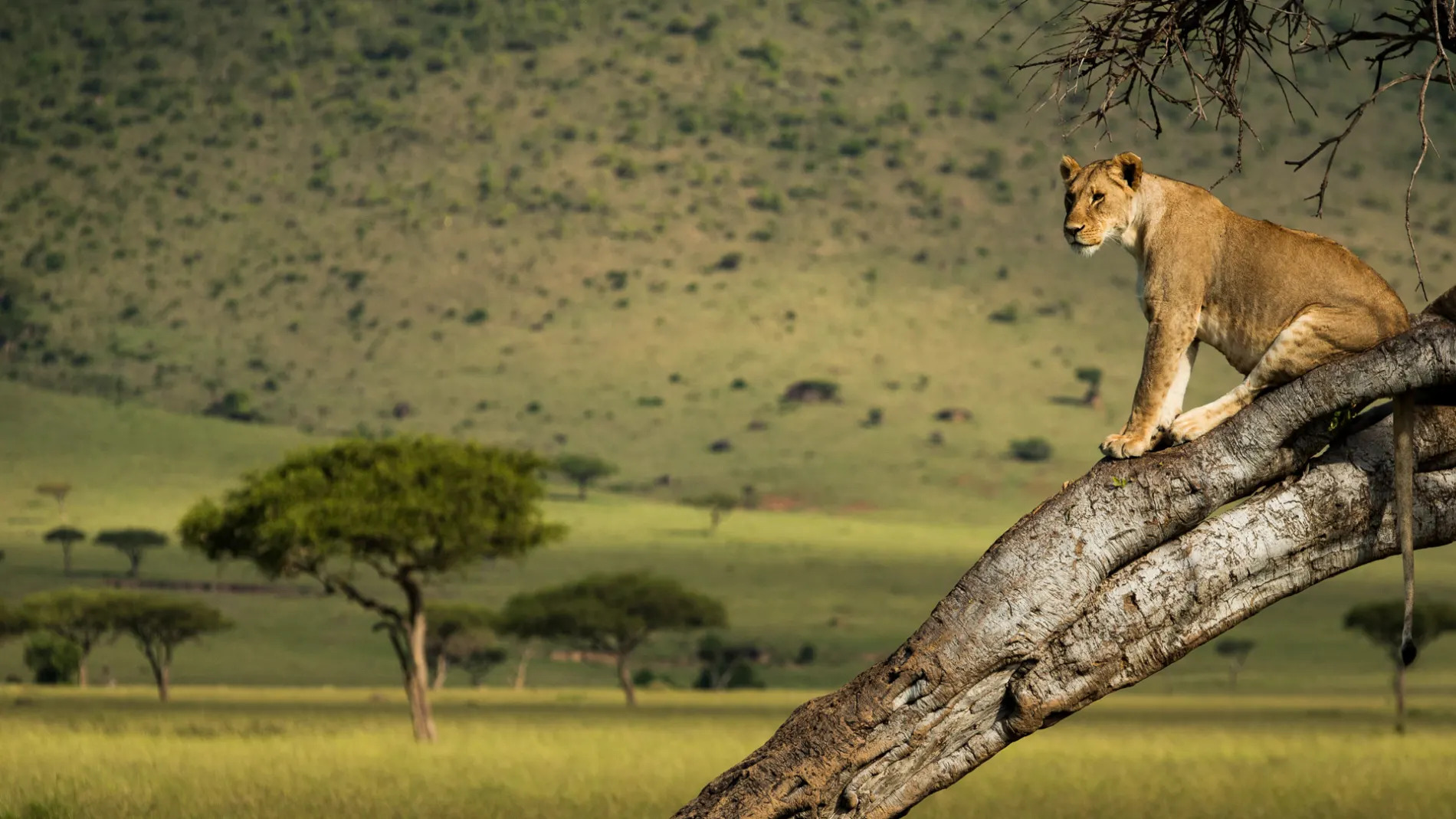
It is simply impossible to showcase everything that happens in our Reserve over the course of a week in a small selection of photographs. Sitting in the Photographic Studio I see a constant wave of delighted guests coming in to edit their images from their daily safaris – the sightings and experiences are extraordinary. Each day every single vehicle is on their own adventure of discovery. And that is exactly what a safari in the Mara is … a Journey of Discovery. “What will we find today?”, “What will I learn?”, “Will today be the day I get THAT photograph?”, and so it goes on and on. It is addictive. I invite you to come aboard my virtual safari vehicle and enjoy a sample of what I witnessed This Week At Angama.

I am astounded at the sheer number of serval sightings at the moment. The grass is the perfect height for them to move around at will, yet still be seen, and photographed. I spent 20 minutes alone with the most relaxed serval I have seen in my guiding career. I am aware of at least 8 sightings so far this week. [f 4.5, 1/1600, ISO 160, +0.33]
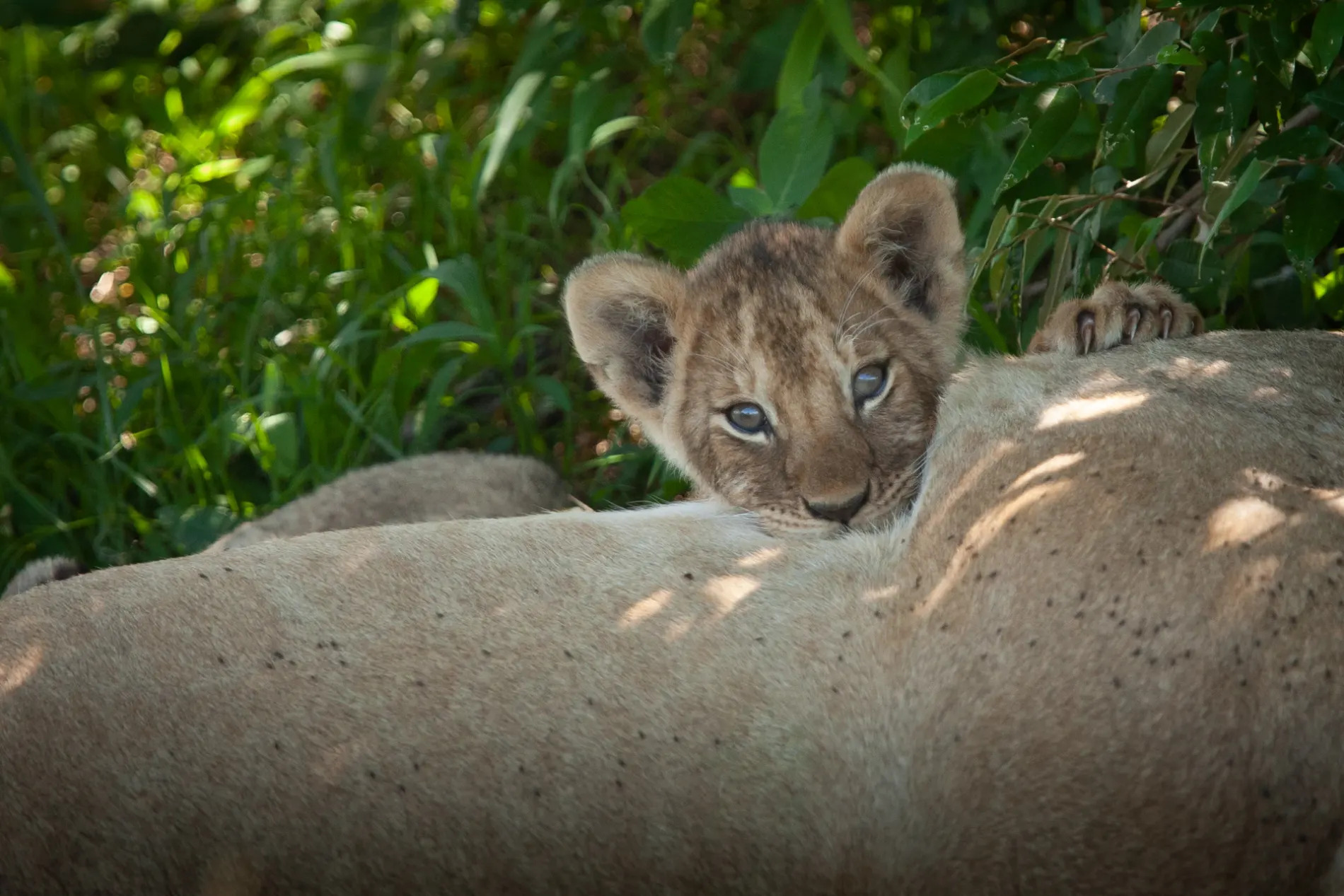
Many weeks ago, I mentioned that come Christmas we would be expecting lots of lion cubs. Well, I am happy to say our predictions were correct. Numerous prides are now starting to reveal to us what they have been celebrating this festive season. Brand new members of our lion prides hidden away in rocky outcrops and drainage lines – all starting to grow in confidence and ability. [f 4.0 1/640, ISO 1000]
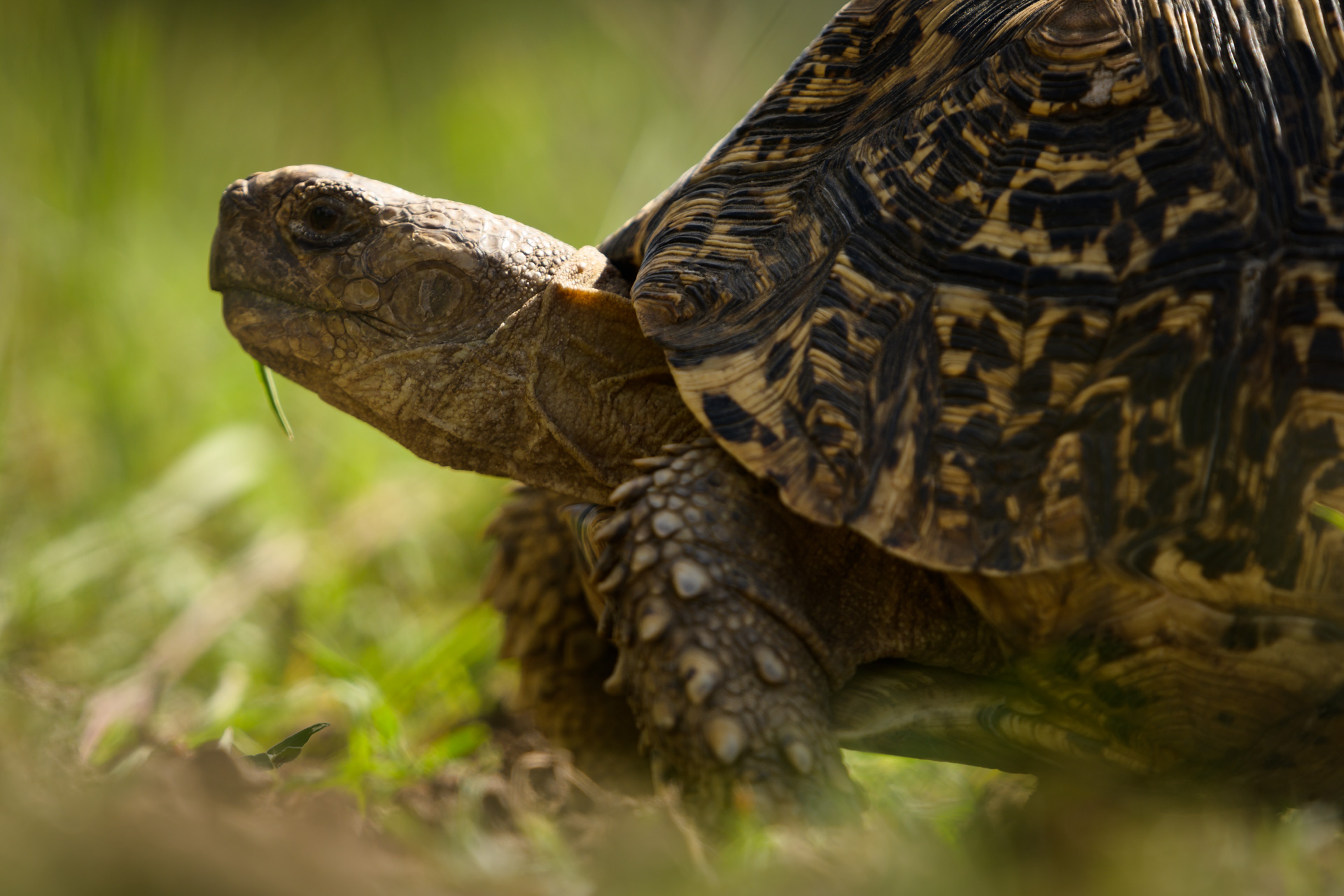
On my one-year anniversary of having lived in the Mara I finally got to see my first leopard tortoise. He was quietly chewing on a blade of grass on the river’s edge. I wonder if he knew how much joy he brought to me that day? This week I also saw my first bushpig sauntering through the open grasslands. Sadly, I was not able to capture a photograph worthy of displaying, but I can tell you that “Moment of Discovery” was a biggie. [f 5.6, 1/640, ISO 200]
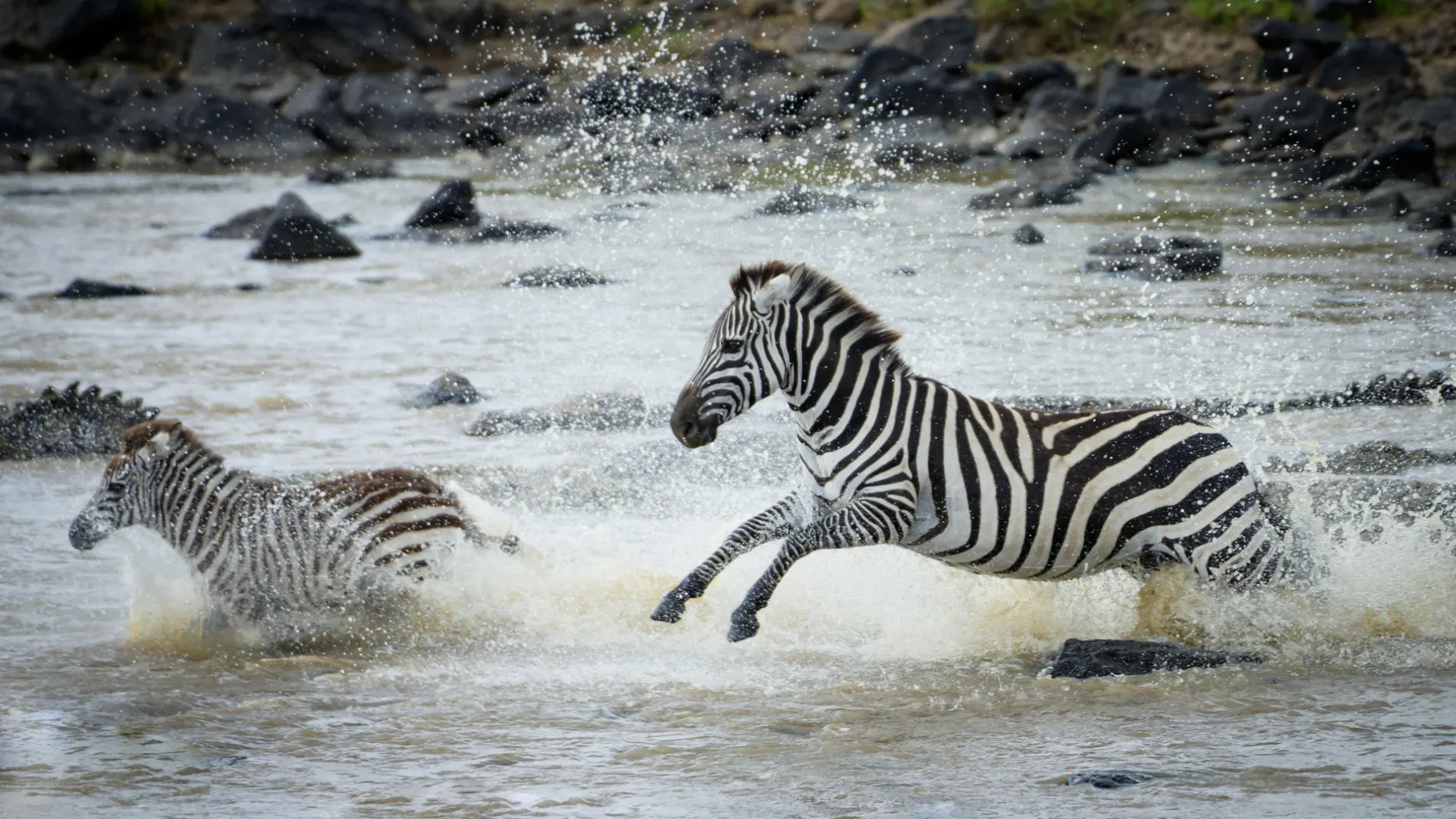
Astoundingly there are still zebra crossings happening on a near daily basis. Massive crocodiles line the water’s edge and the zebras have to run/swim the gauntlet if they are to cross. [f 5.6, 1/1250, ISO 800]
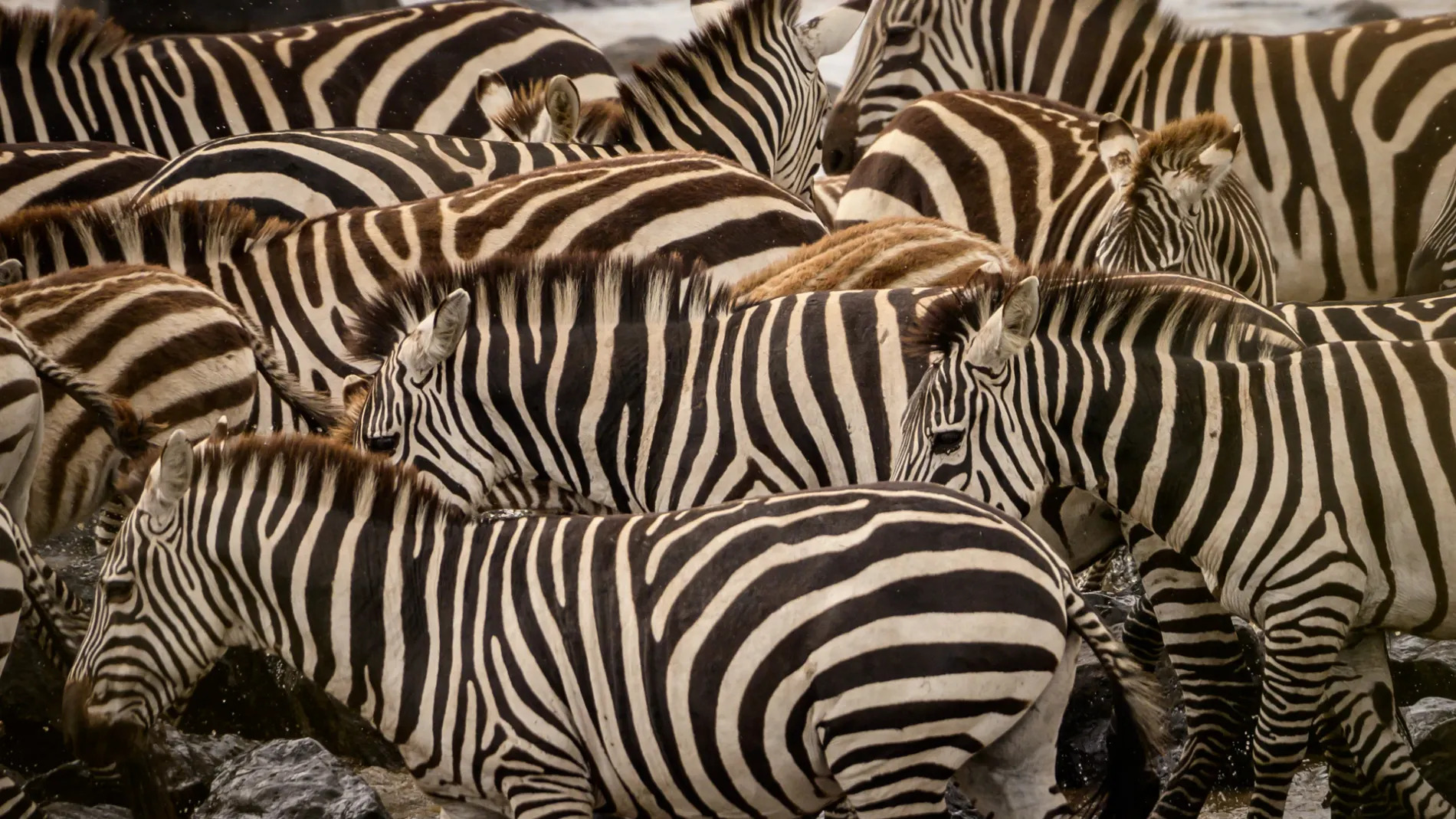
This time last year, when I arrived, there were only a handful of zebra to be seen. Now there are thousands still happily grazing on the lush grasslands. [f 5.6, 1/1600, ISO 800, +0.33]

I am always looking for fresh ways to photograph subjects. I loved the contrasting green colours of the foliage and the natural frames it created. [f 5.6, 1/1600, ISO 800, -0.33]

I didn’t take this photograph because it had two male cheetahs walking side by side. I took it because of what was next to them: an ostrich egg. After sighting these cheetahs from a fair way off we came across what seemed like an abandoned solitary intact egg. We moved back to allow the brothers space, hoping they would find the egg. They walked directly passed the egg without even giving it a second glance. I was quite surprised as I was sure this was going to make a good meal; and a comical sighting to see how they would try to crack it open. [f 5.0, 1/1000, ISO 160]
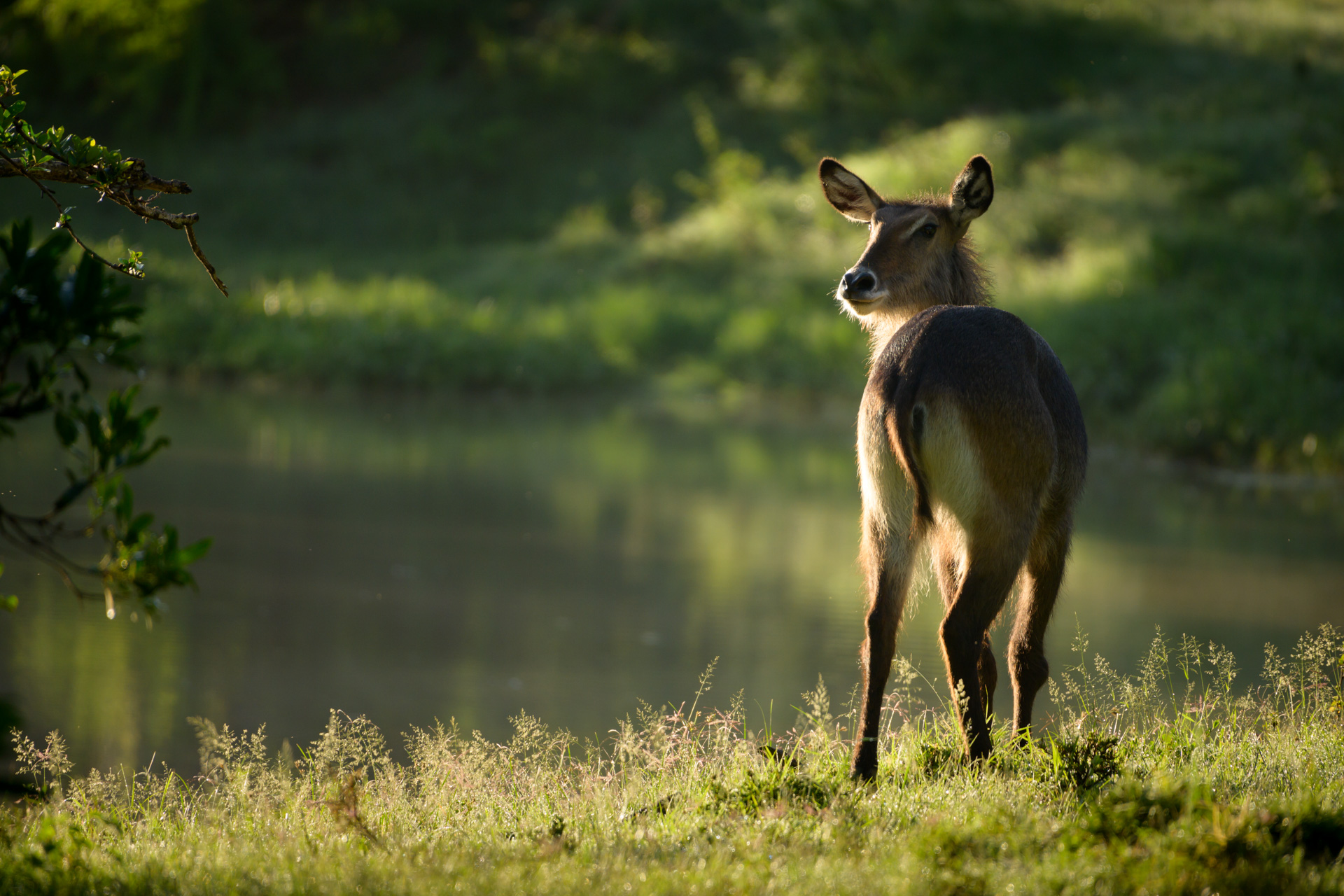
It is a delight each morning to pass by the Angama Dam. You never know which animals will be making their way down the slope for a drink. In this case a beautiful female waterbuck highlighted by a gentle sidelight. [f 5.6, 1/640, ISO 500, -0.33]

I spent nearly 2 hours with one of the two brothers that make up what is affectionately known as the Kichwa Coalition. It was obvious this male was onto the scent of something, or rather someone, as he strode across the open plains nose to the ground like a sniffer-dog. [f 5.6, 1/5000, ISO 500, -0.33]

We are delighted to announce that the Angama Pride also has brand new cubs. Although I have yet to see them I can confirm that some lucky guests have seen three little bundles of joy. We are giving them a lot of space, as they are denned in a deep erosion gully, allowing them time to bond with their mother. We wait with excitement for them to be brought out into the open for us to marvel at. Will they feature in This Week At Angama #50? [f 4.0, 1/4000, ISO 1000, -0.33]
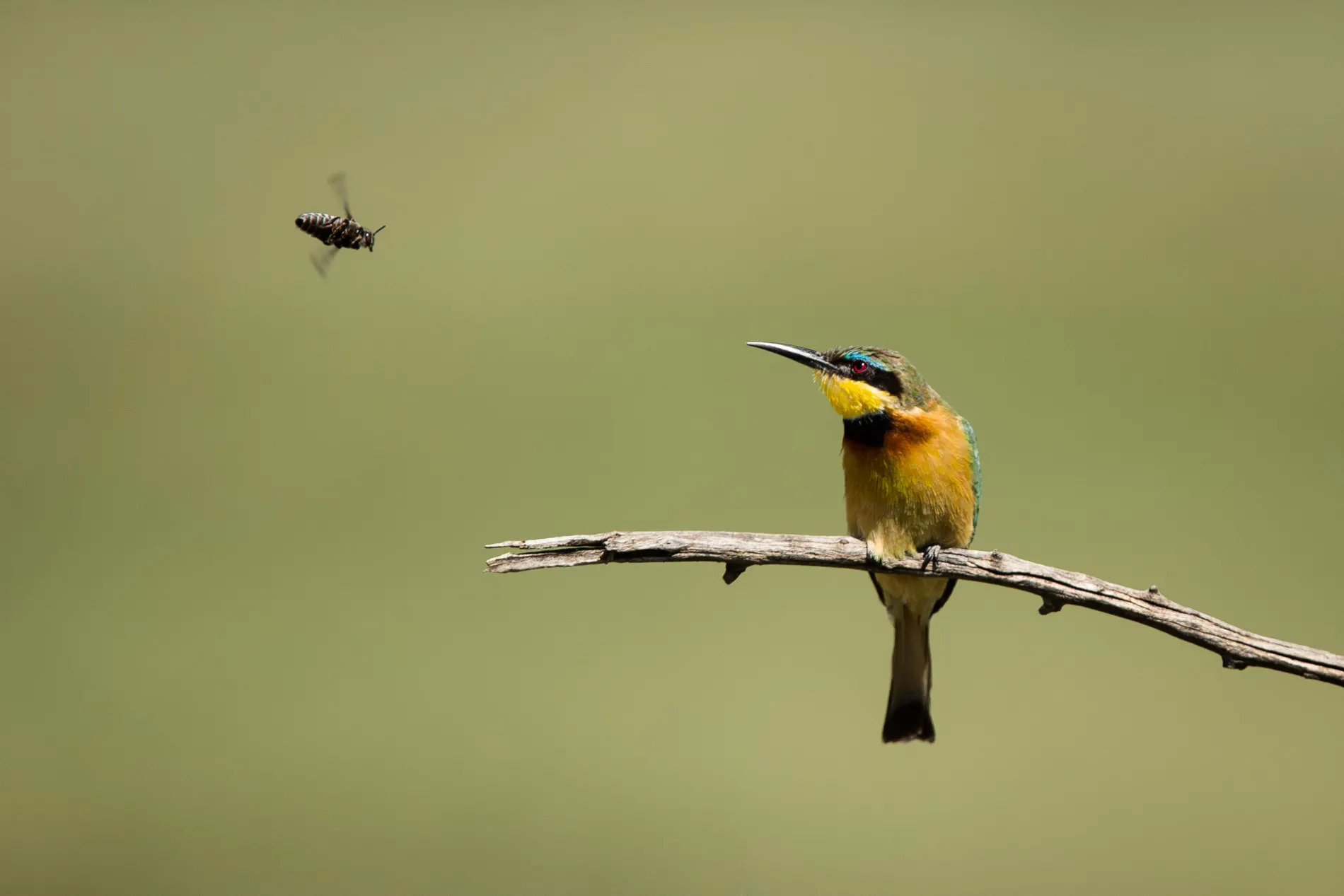
Whilst waiting for zebras to cross the Mara River my interest was captivated by a little bee-eater who was hawking bees and insects from a branch overhanging the river. On this specific occasion the bee (species unidentified) was too large for the bird and actually successfully managed to chase the bird away. Ironic I thought, and very amusing. It made for such a great photograph of one of the easily overlooked interactions in the bush. [f 4.5, 1/2500, ISO 320, +0.33]
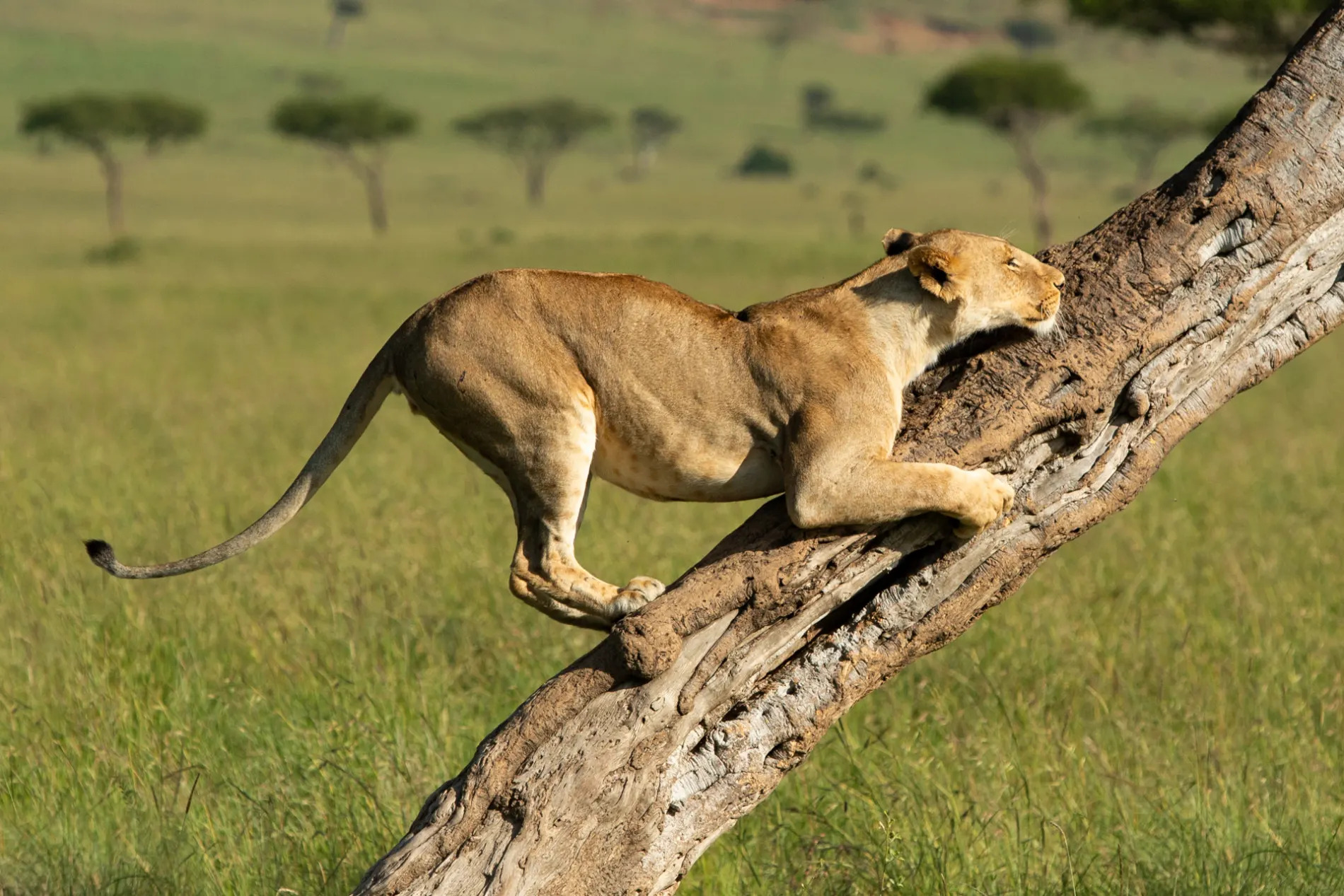
This week I conducted a series of private photographic tuition drives. The purpose of these is to assist Angama guests to come to grips with some of the more complicated aspects of photography. No matter what level you start at, my aim is to make our guests leave with life-time memories and fantastic photographs they can display on their walls. Like this lioness attempting to climb up a tree. [f 5.0, 1/2500, ISO 250, -0.33]
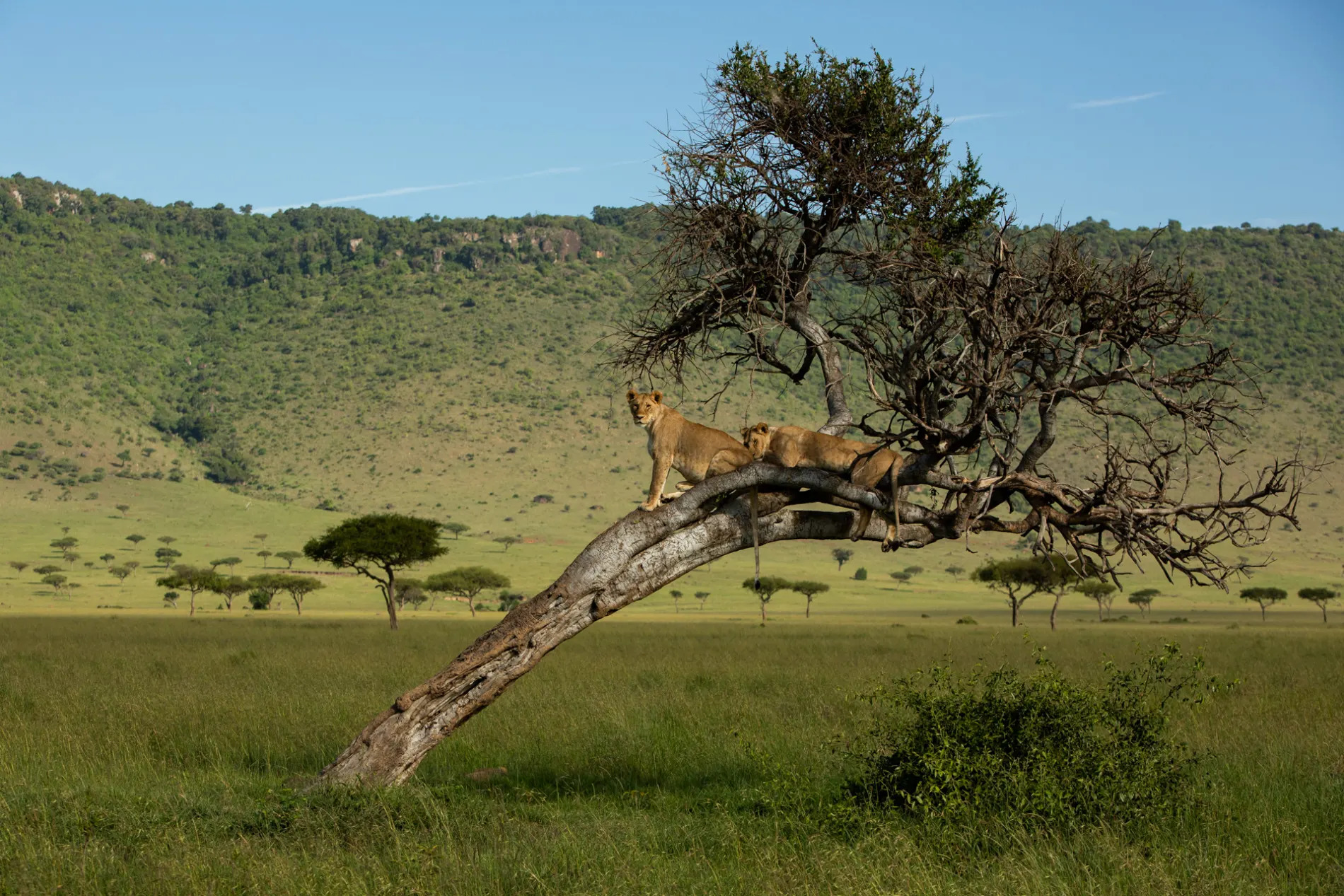
Eventually she managed to get up the tree and was later joined by her sister. The Oloololo Escarpment makes for the perfect backdrop. Could you ask for a better set of models on which to fine-tune your photography? [f 5.6, 1/2000, ISO 320, -0.33]
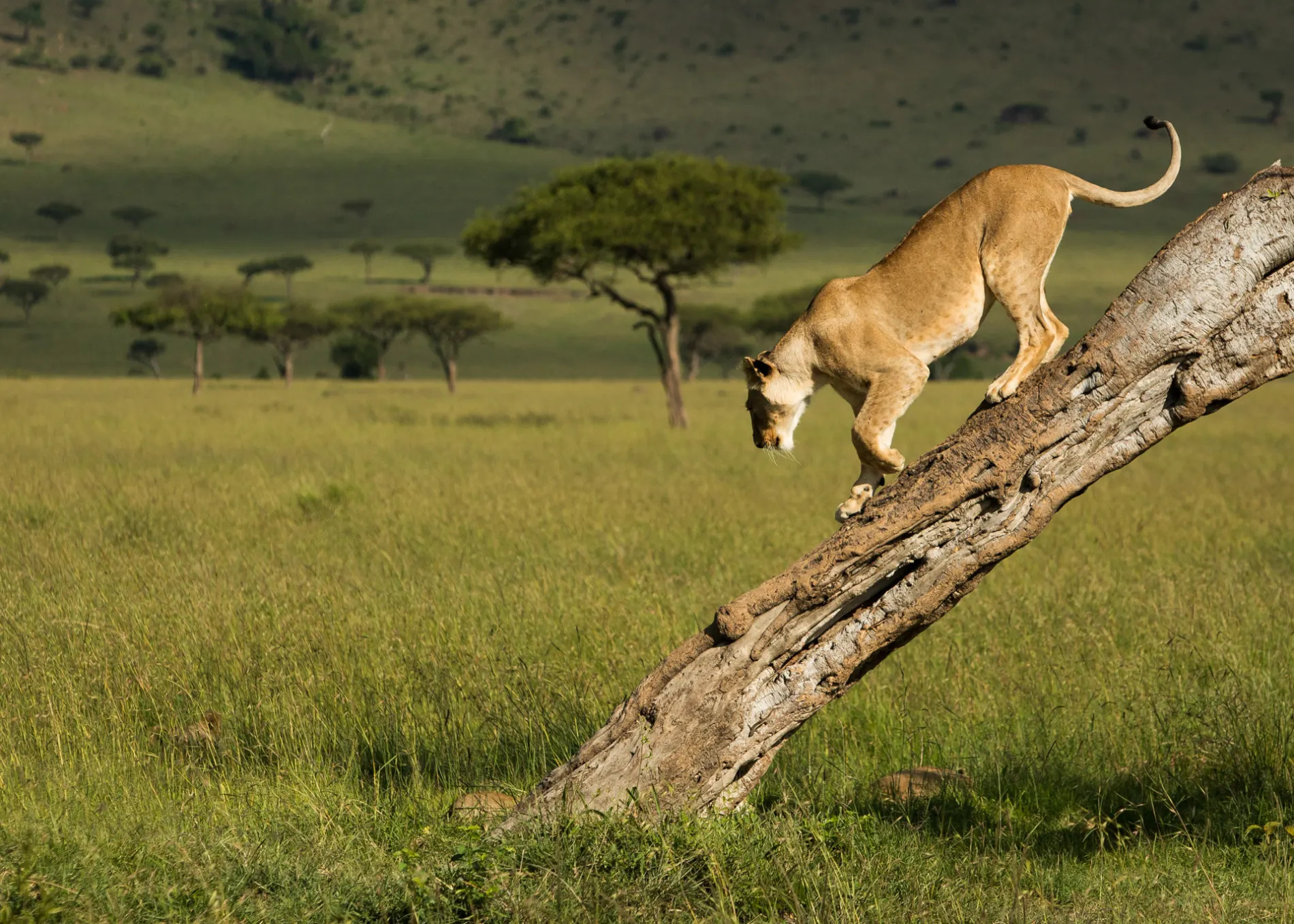
But what goes up, must come down. [f 5.6, 1/2000, ISO 320, -0.33]
I finish off this week’s selection of images with one of the most emotional sightings I have ever had in the bush. Photographically it was a real challenge, as there was so much happening that it was a case of not really knowing where to look, but at the end of the day I think I managed to capture the story effectively. Nature can be pitiless …
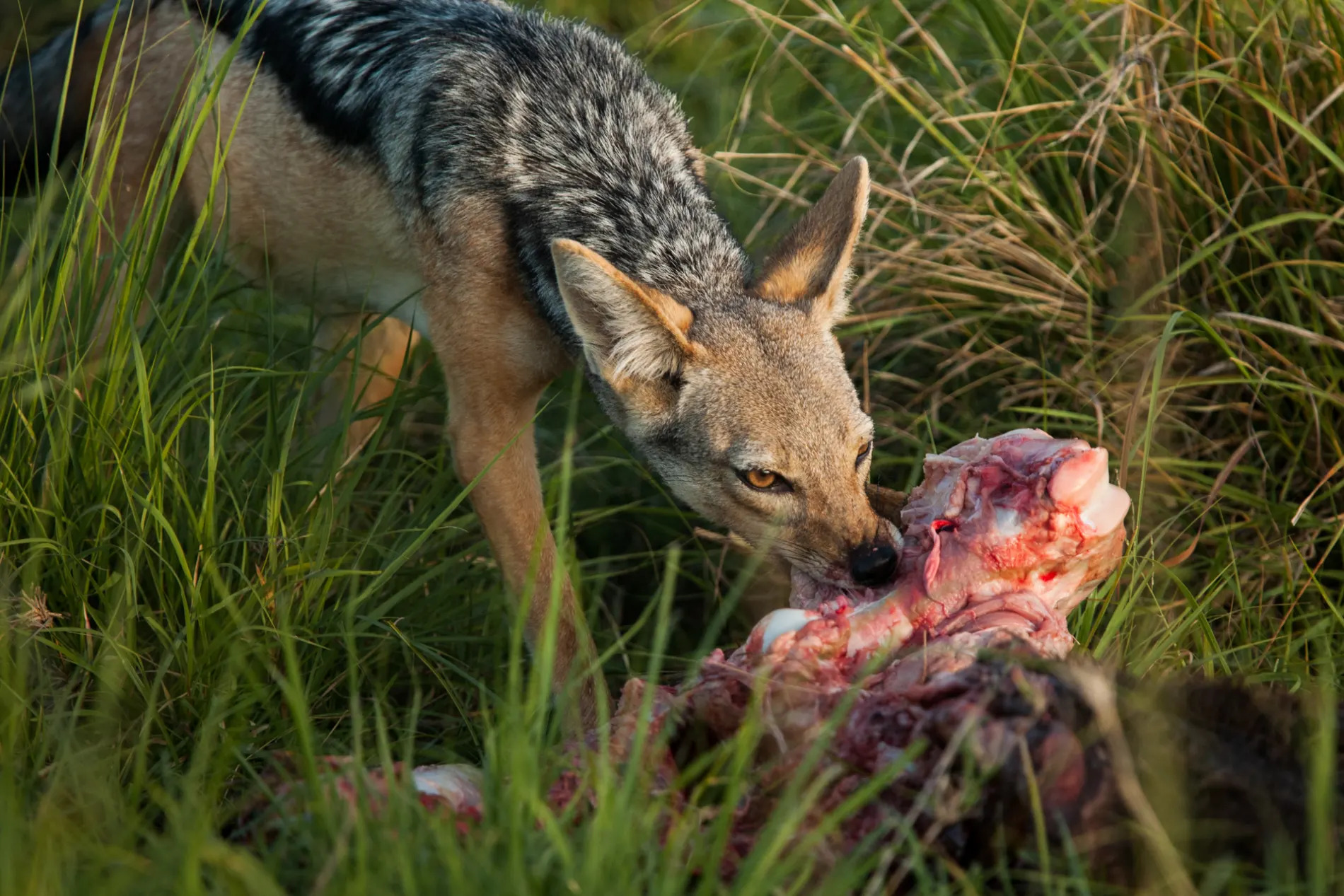
In the early morning hours, we came across a recently killed new born buffalo calf. A jackal was frantically feeding on it. We don’t know what caused it’s death. [f 4.0, 1/800, ISO 640, -0.67]
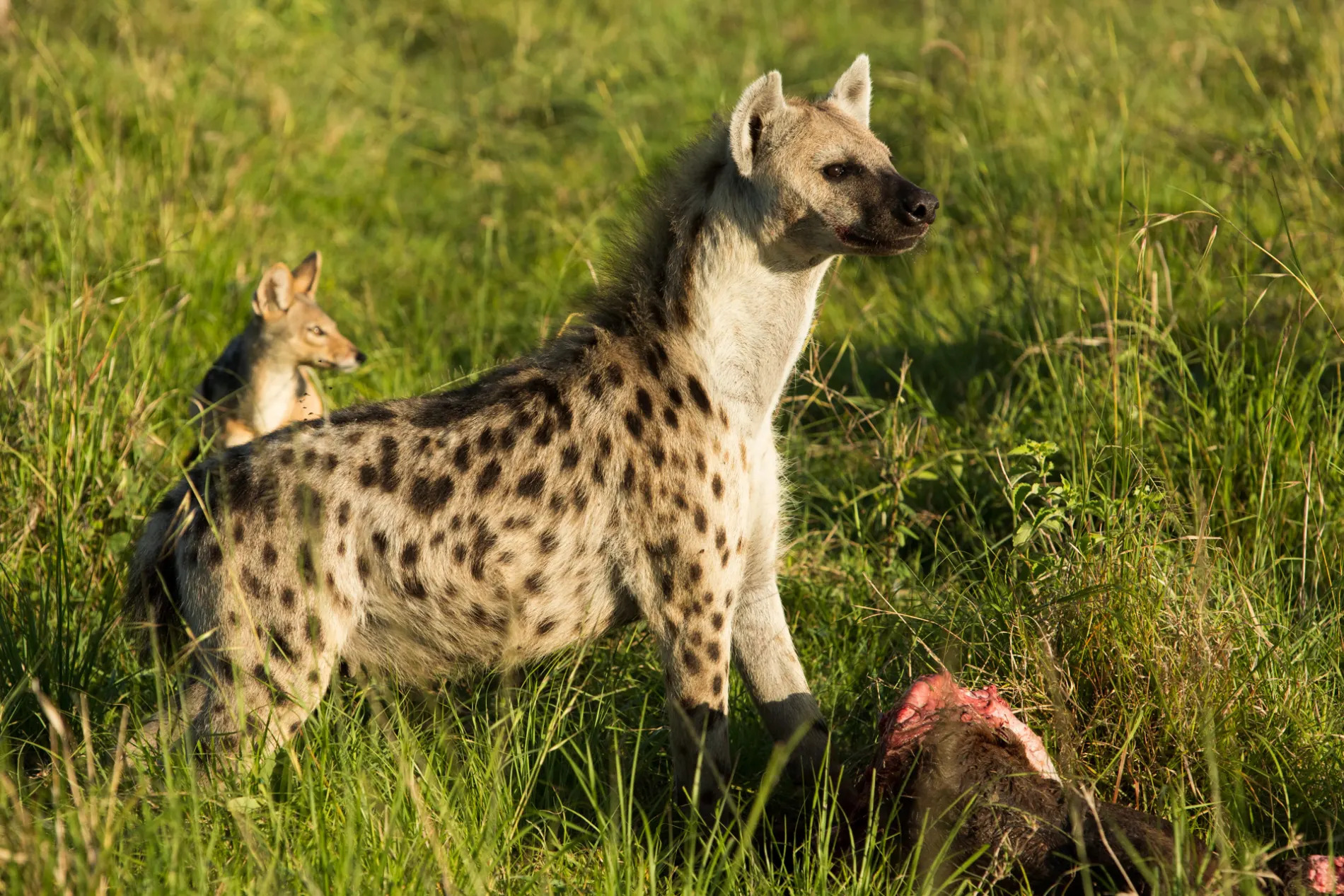
Within minutes a hyena arrived on the scene and chased the small jackal away. Both scavengers looked nervous as the sky started to fill with circling vultures. [f 6.3, 1/2500, ISO 800, -0.33]
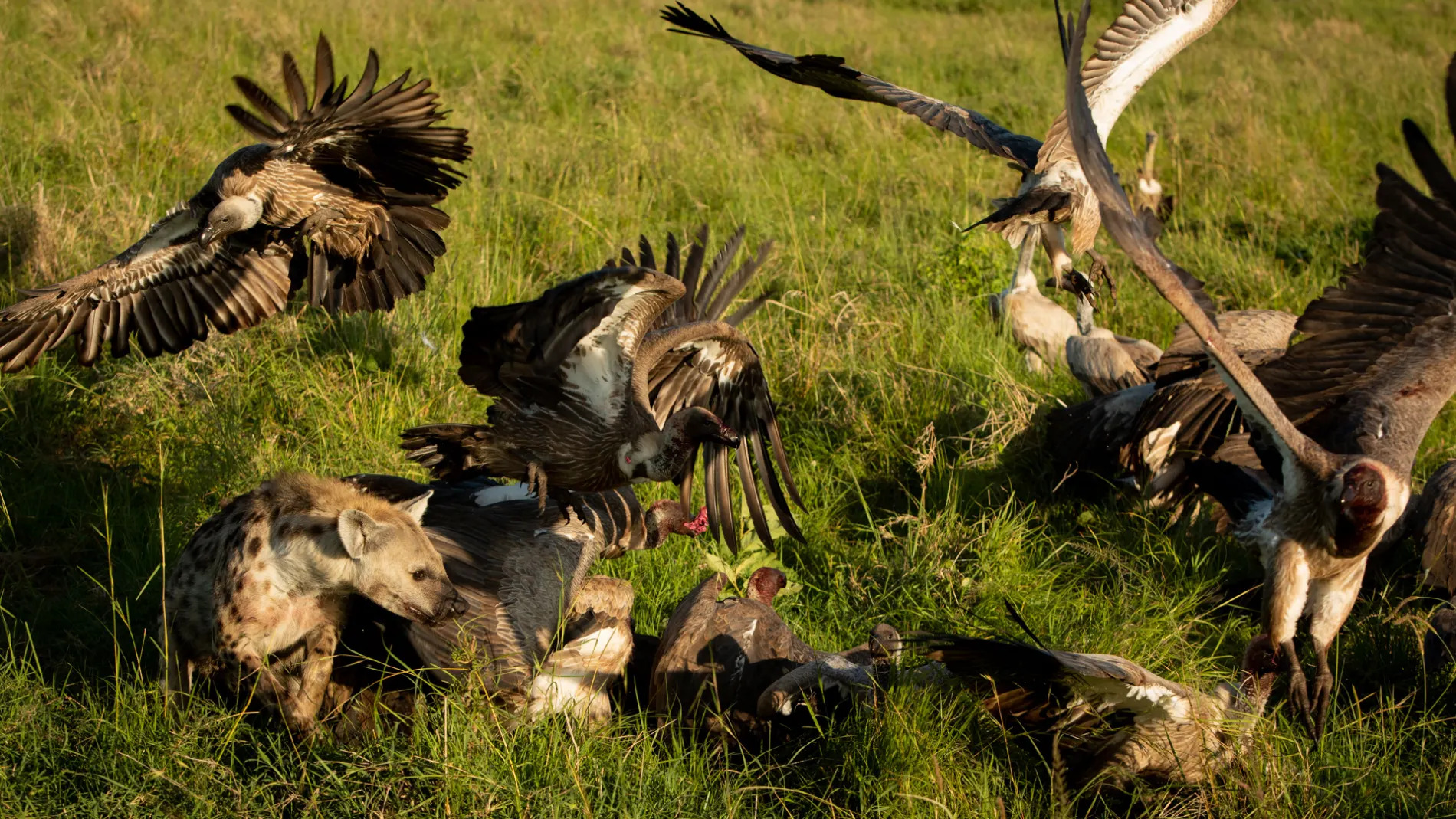
The vultures descended in huge numbers. Where on earth had they come from? The hyena battled to keep control of the carcass. [f 6.3, 1/2000, ISO 800, -0.33]

In the distance, hundreds of meters away, we could see the lonesome and obviously distressed figure of a buffalo cow running around. It was clear she was searching for her lost calf. She got closer and closer and within minutes she was thundering in our direction. [f 4.0, 1/2500, ISO 640]
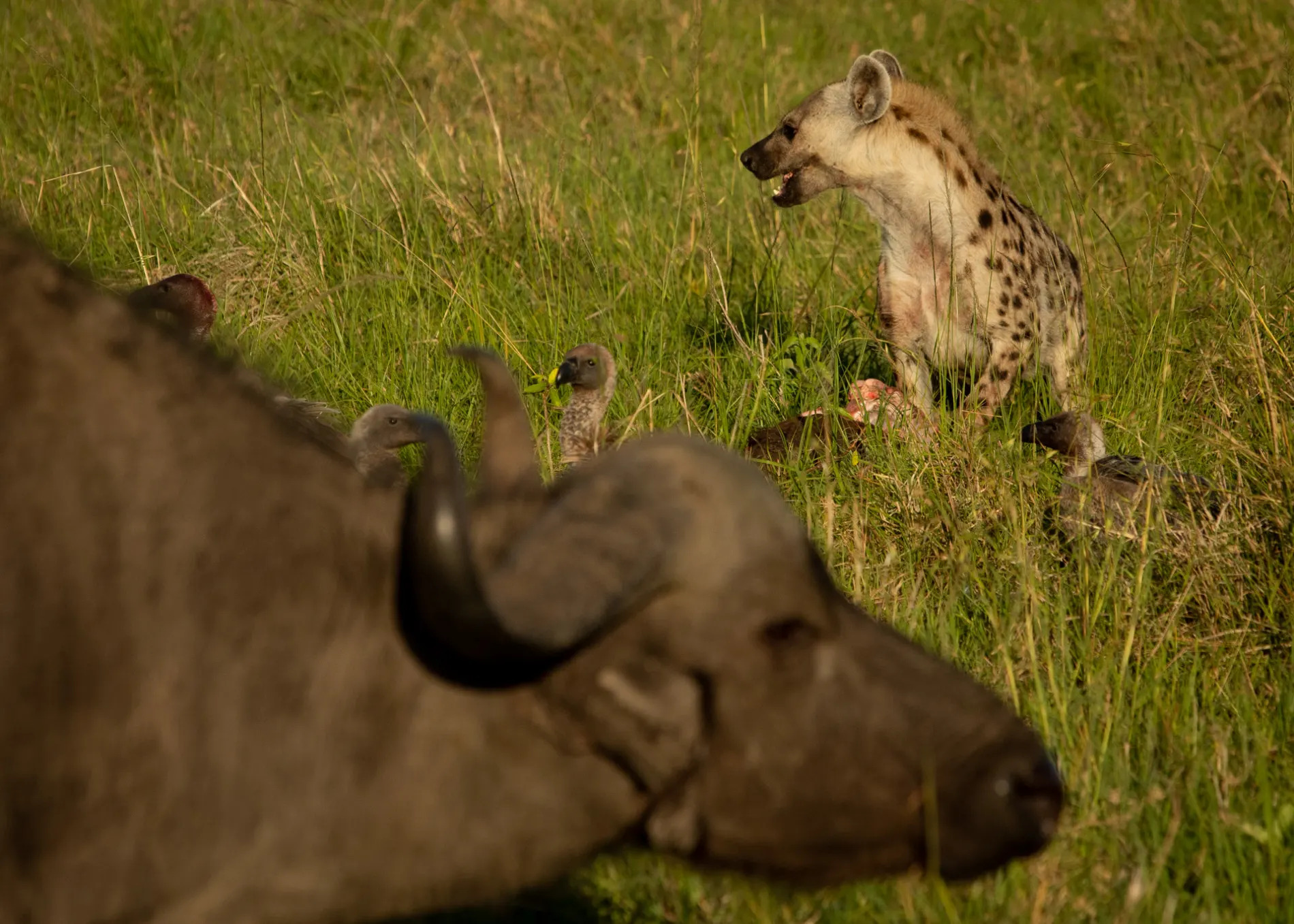
The agitated mother circled the scene. Nose to the ground she could smell her newborn. But she couldn’t find it. Meanwhile, the hyena gorged himself. [f 6.3, 1/3200, ISO 640, -0.33]

It didn’t take long for the buffalo to face off with the hyena. [f 6.3, 1/2500, ISO 640]
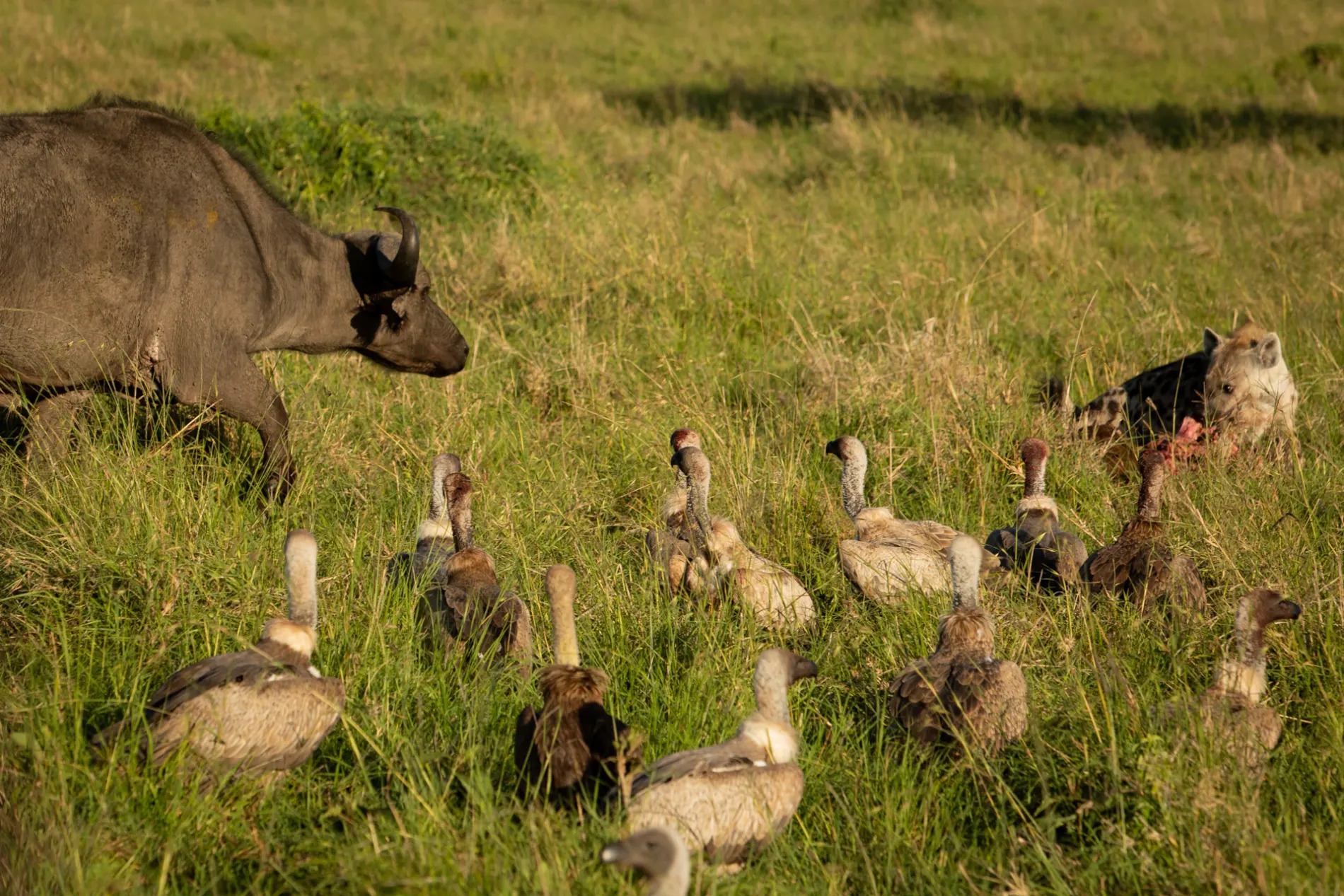
She moved in at speed chasing the hyena off. [f 6.3, 1/2000, ISO 640]
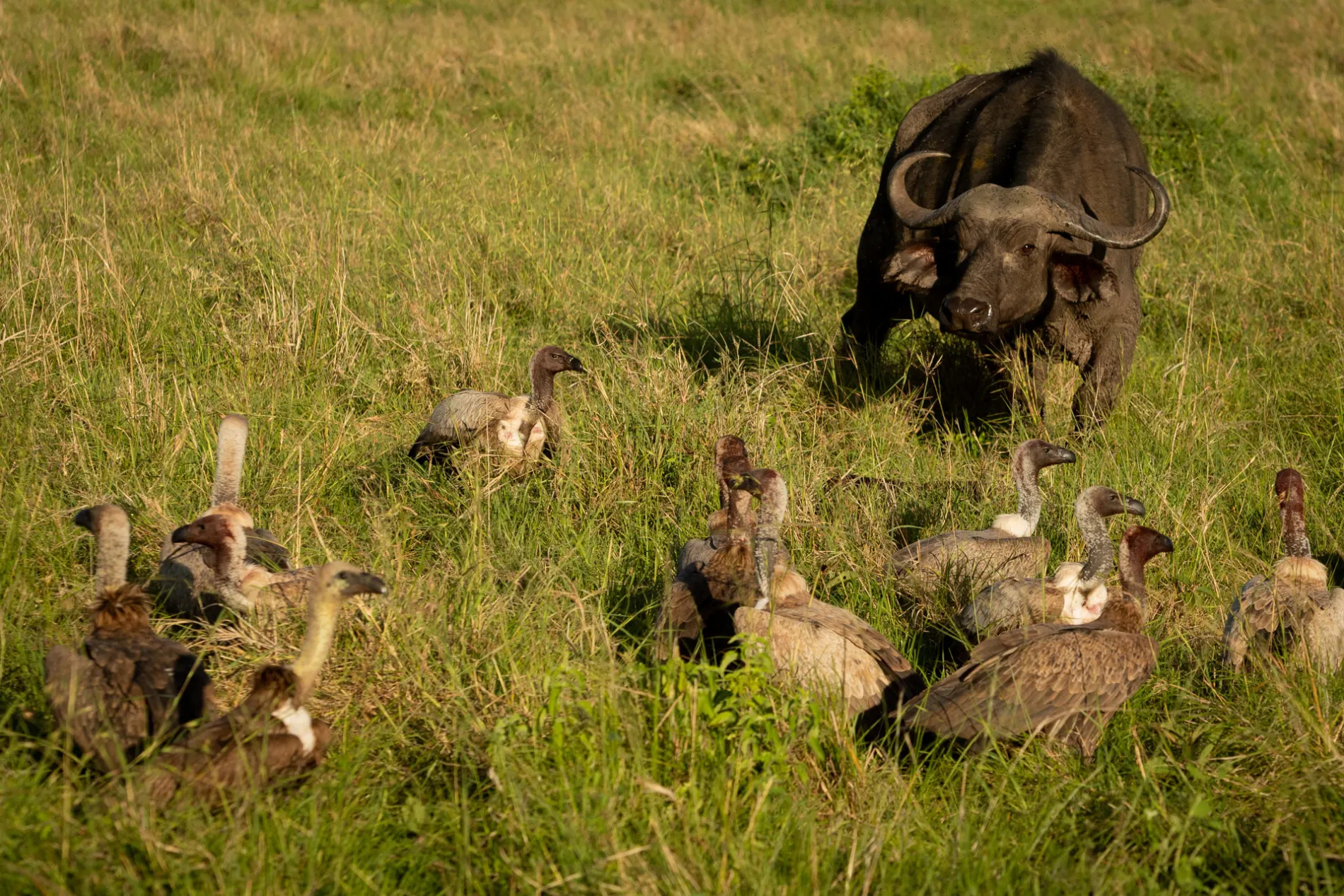
With the hyena now out of the picture the vultures moved in en masse and literally surrounded the carcass whilst the mother was still investigating and coming to grips with what had happened. [f 6.3, 1/2000, ISO 640]
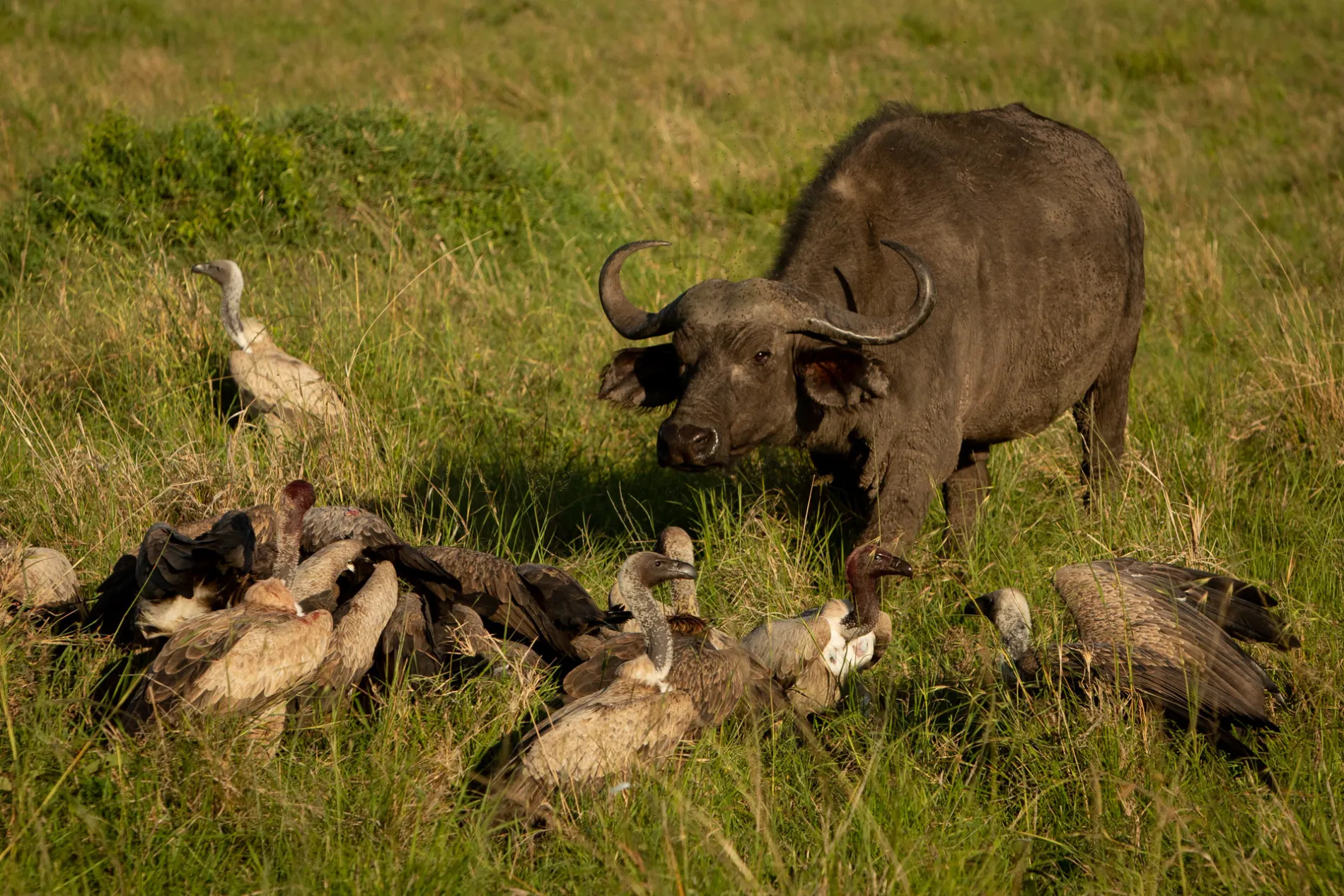
The mother wasn’t giving up and spent the next few minutes calling in distress and trying to keep the vultures off of her calf. There was no hope. [f 6.3, 1/2000, ISO 500, -0.33]
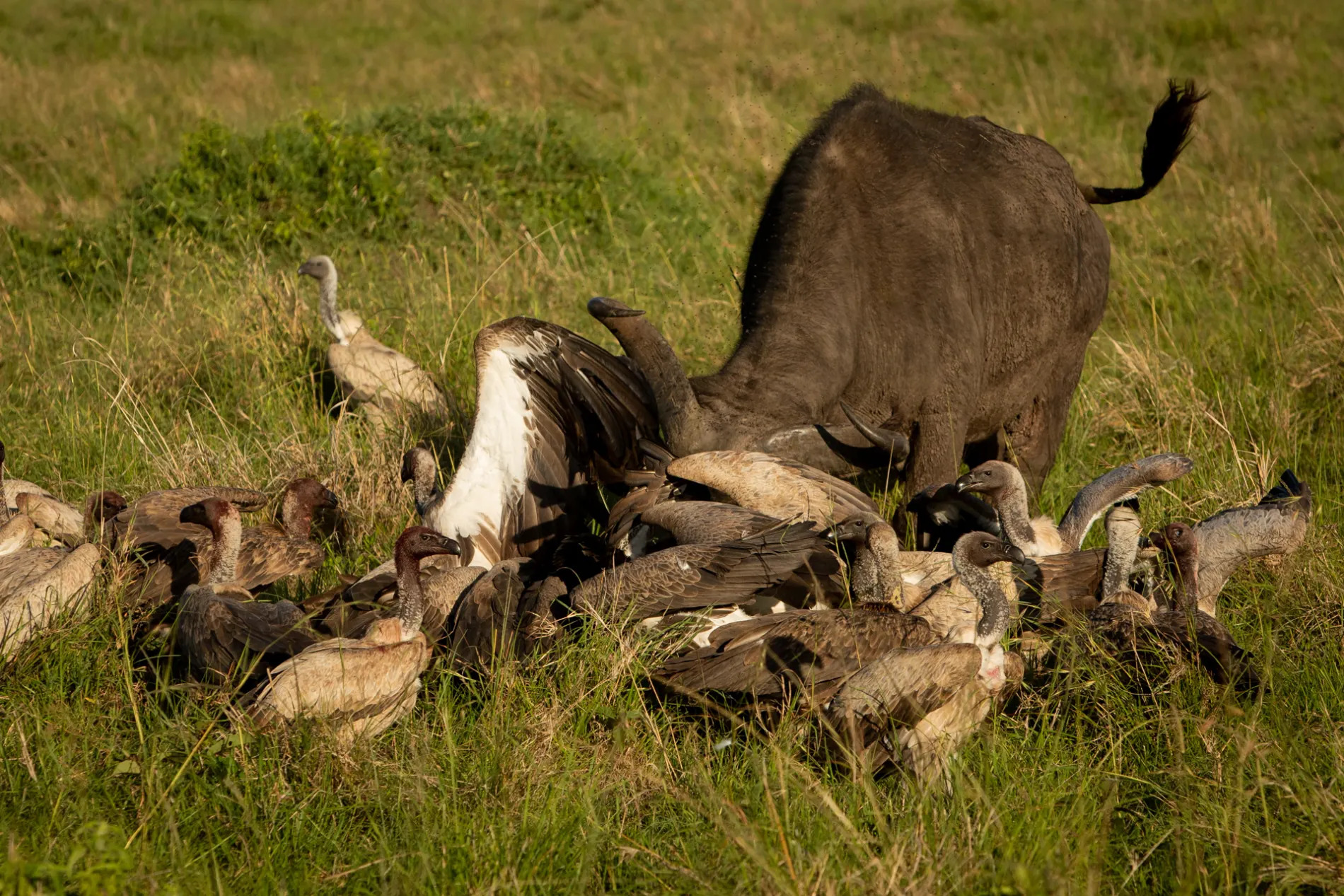
[f 6.3, 1/2000, ISO 500, -0.33]
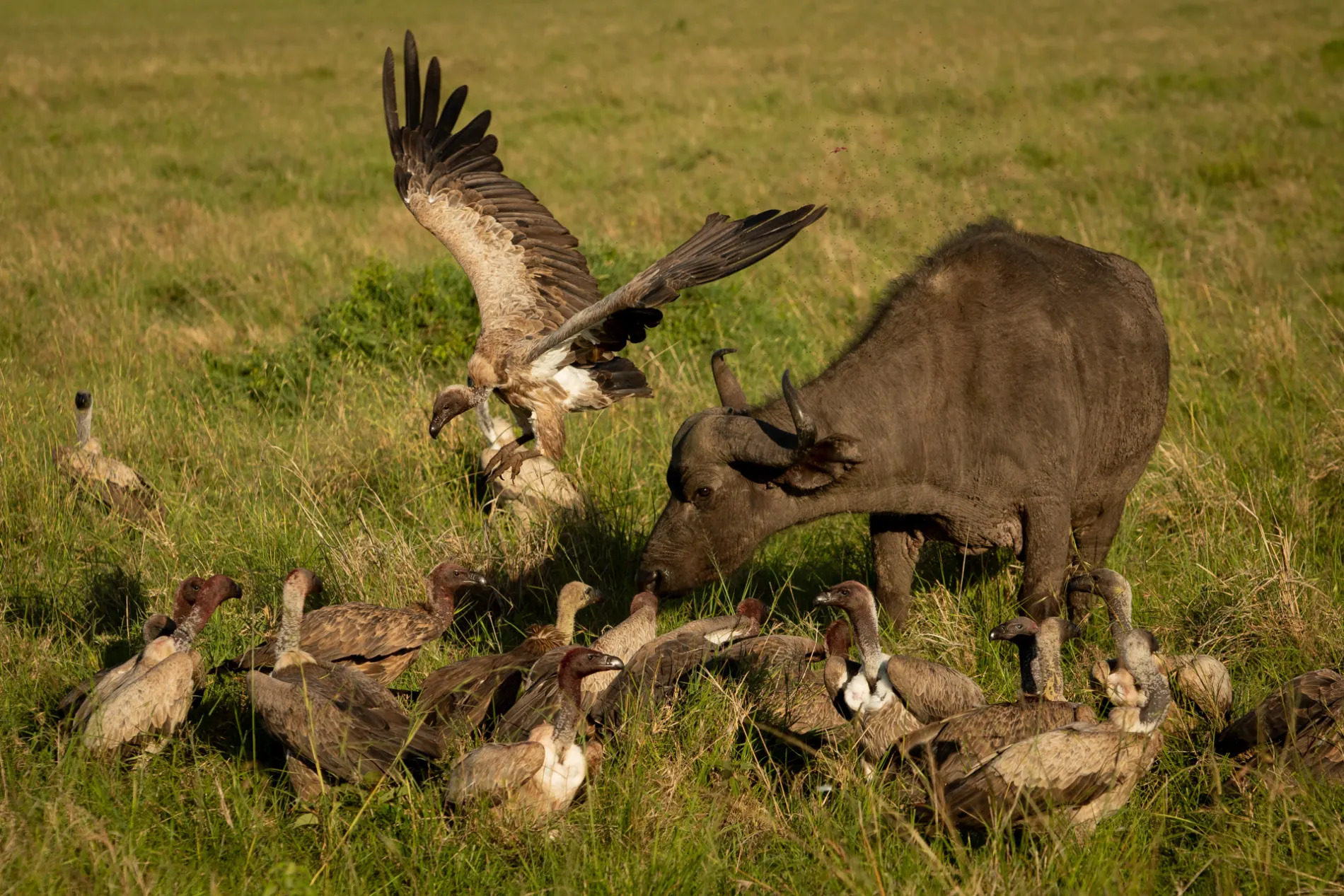
[f 6.3, 1/2000, ISO 500, -0.33]

[f 6.3, 1/2000, ISO 640]

Regardless of how much she tried to keep the increasing vulture numbers at bay, she could no longer. It was pointless. In a desperately sad moment she turned her back and let out a painful bellow. Her body shrunk as she slowly walked away from the scene. No one can tell me animals don’t have feelings. [f 6.3, 1/2000, ISO 640]
Within minutes there was not a scrap of meat left, not a trace of the heartbreaking scene that had just unfolded. As a guide and a wildlife photographer I am constantly exposed to drama: the emotions are so incredibly varied. One second you are gazing at a cub in sheer elation, bouncing on cloud nine. The next minute you have front-row seats to watching death walk by. I admit it can be very hard to watch. However, I always remind myself that this is the way life works out here and that I am in the most privileged position to be able to witness these events unfold. You never know what you will get when out on a drive in the African wilderness – and it is exactly this which keeps so many of us coming back for more. The inner pull of ‘Discovery’.
TAGGED WITH: Wildlife, Photography, Maasai Mara, Safari, Wildlife Photography, Buffalo, Lions of the Mara



COMMENTS (7)
Francis Bagbey
January 11, 2019That bee-eater picture—WOW!!!
REPLYLYNN
January 11, 2019The buffalo story , so heartbreaking, true animals too have feelings.
REPLYBrian Sonnier
January 11, 2019Keep up the great work. I love getting these updates each week.
REPLYNicky Fitzgerald
January 12, 2019Thanks so much Brian – it gives us all much joy to hear from our readers
REPLYGillian Evans
January 11, 2019Incredible collection of photos Adam and what a heart wrenching moment to witness the buffalo calf death and the mother’s loss . There is so much to see in the Mara Triangle and always something different! Miss the Mara and Angama Mara !
REPLYPenny
January 12, 2019Thank-you for the beautiful photos and accompanying stories. It’s the highlight of the week for me!
REPLYNicky Fitzgerald
January 12, 2019That is great to hear – thank you so much Penny
REPLY